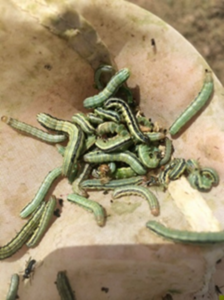Over the past couple days, I’ve gotten a few reports of fall armyworms in pastures on the Mississippi/Alabama border with Tennessee. Tennessee will still have armyworms that migrate North and infest pastures, food plots and the occasional yard every year. However, the situation that happened in 2021 was a very unique event and will not occur yearly. That being said, reports of armyworms in 2024 are roughly two weeks earlier than what we typically see.

Fall armyworms don’t overwinter in Tennessee and populations migrate North from Texas and Florida every year. The difference in 2021 vs 2023-24 is the conditions that were occurring in April and May in South Texas. Texas experienced a warm and unseasonably wet spring that allowed for the proliferation of extremely large numbers of armyworms. Large numbers of moths plus ample food supply in pasture grasses, fallow grasses, yards and pretty much anywhere that had grass allowed this “army” to make its way North. Texas experienced outbreaks first followed by Louisiana, Arkansas, Mississippi then Tennessee with the moth flight culminating, in Canada, in November. I ask my colleagues, in Southern states, weekly if they are seeing any armyworms or anything resembling what happened in 2021 and the answer has consistently been no. My colleagues in Arkansas are getting calls about armyworms in rice and pastures but nothing even close to what was experienced in 2021.
If you do see armyworms it shouldn’t be automatically assumed that pyrethroids won’t be effective. We don’t fully understand why pyrethroids provided inconsistent control in 2021. Resistance is a possibility but overlapping generations causing mixing of various worm sizes resulting the appearance of poor control is another possibility. Also, since armyworms don’t overwinter in Tennessee and there is no evidence of reverse migration, the armyworms we experienced in 2021 won’t be the same ones we see in subsequent years. However, if pyrethroids do fail to control armyworms please contact your local county agent.
Going forward, pasture treatments should be considered when armyworm populations exceed 3 to 4 worms per square foot. If fields are ready or near ready for cutting, harvesting is suggested rather than applying an insecticide. Producers may watch for the presence of birds in a field as an indicator of armyworms. This method should not be the only one used to check for armyworms because this indication often is too late to avoid field injury. Early signs of infestations by small larvae cause plants to have a “window-paned” appearance. This is due to the larvae’s inability, at small sizes, to chew completely through the leaf blade leaving the upper epidermis intact. Large areas of window panning will give fields a frosted appearance. Ideally, scouting should be initiated in late July to early August without the presence of birds or frosted patches appearing so infestations can be caught early. When scouting during times when armyworms are not feeding (midday) be sure to dig through the thatch layer and check the base of plants. Detection of frass (insect excrement) is also a sign that armyworms may be present in a field.
Information on grazing restrictions, application rates and insecticide choice can be found below.
The take home is scout early and often for armyworms in pastures, hayfields and turf areas. It may be prudent to initiate scouting earlier than we’re accustomed to catch any early infestations that may slip by.

